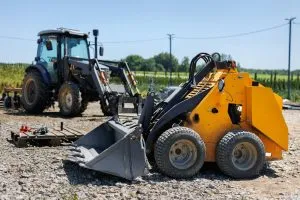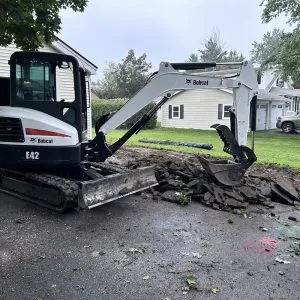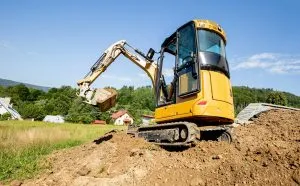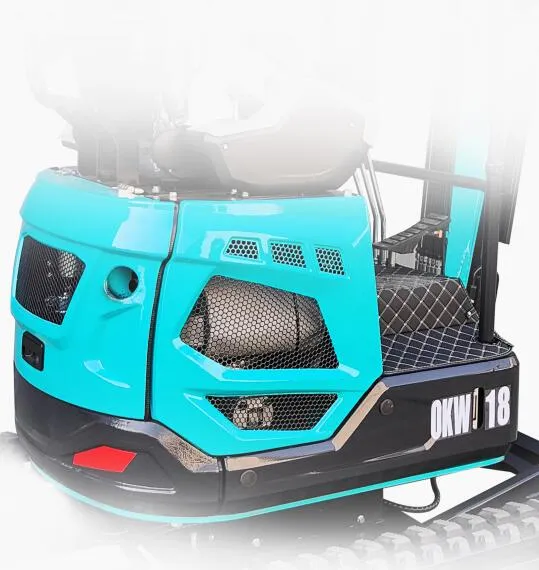In the ever-evolving world of construction, the need for versatile and efficient machinery is paramount. Among the array of heavy equipment available, compact (mini) excavators have carved out a significant niche. These small but powerful machines offer a range of capabilities that make them indispensable on various job sites. Whether you’re involved in landscaping, urban construction, or even home renovation projects, understanding what a compact excavator is and how it can be used is crucial for maximizing efficiency and productivity. This article delves into the intricacies of compact excavators, exploring their design, functionality, and the myriad of applications they serve.

1. Introduction to Compact (Mini) Excavators
Compact, or mini, excavators are a scaled-down version of standard excavators. These machines are typically defined by their operating weight, which usually ranges between 1 to 10 tons. Despite their smaller size, mini excavators retain the core functionalities of their larger counterparts, including a rotating cab, a powerful hydraulic system, and the ability to use various attachments.
1.1. Brief History and Evolution The concept of compact excavators emerged in the 1960s when Japanese manufacturers first introduced these machines. The idea was to create an excavator that could perform in confined spaces where traditional, larger excavators could not operate efficiently. Over the years, the design and capabilities of mini excavators have evolved significantly, incorporating advanced technology to enhance their performance and versatility.
1.2. Key Components of a Compact Excavator Understanding the key components of a compact excavator is essential for appreciating its functionality. These components include:
- Boom and Arm: The boom and arm are the two primary parts of the excavator’s hydraulic system that allow for digging and lifting operations.
- Cab: The cab houses the operator and the controls. Modern cabs are equipped with ergonomic seats, joysticks, and sometimes even air conditioning.
- Undercarriage: The undercarriage includes the tracks or wheels and the drive mechanism, providing mobility and stability.
- Hydraulic System: The heart of the excavator, the hydraulic system powers all movement and lifting actions.
2. The Different Types of Compact Excavators
Compact excavators come in various sizes and configurations to suit different applications. The primary distinction lies in their operating weight and size, but there are other variations as well.
2.1. Micro Excavators Micro excavators are the smallest category, often weighing less than a ton. These machines are ideal for extremely tight spaces and delicate tasks where precision is more critical than power.
2.2. Mini Excavators Mini excavators typically range from 1 to 5 tons in operating weight. They are versatile and can handle a variety of tasks, from digging and trenching to demolition and grading.
2.3. Mid-Sized Compact Excavators While still considered compact, these machines can weigh up to 10 tons. They offer more power and reach, making them suitable for more demanding tasks that require a balance of maneuverability and strength.
2.4. Zero Tail Swing Excavators A subset of compact excavators, zero tail swing models have a design where the rear of the machine does not extend beyond the tracks during rotation. This feature is particularly useful in tight or urban environments where space is limited.

3. Key Features and Technology in Compact Excavators
Modern compact excavators are equipped with a range of features and technologies designed to improve their efficiency, safety, and ease of use.
3.1. Advanced Hydraulic Systems The hydraulic system is the powerhouse of the excavator, and advances in hydraulic technology have greatly enhanced the capabilities of compact excavators. Variable displacement pumps, load-sensing hydraulics, and auxiliary hydraulic circuits allow for smooth and precise control of attachments and movements.
3.2. Operator Comfort and Safety Manufacturers have placed a strong emphasis on operator comfort and safety. Features such as adjustable seats, climate control, low noise levels, and intuitive control layouts contribute to reducing operator fatigue and increasing productivity. Safety features like rollover protection structures (ROPS) and falling object protective structures (FOPS) are also standard in many models.
3.3. Attachments and Versatility One of the defining characteristics of compact excavators is their ability to use a wide range of attachments. From buckets and augers to hammers and thumbs, these machines can be equipped to handle almost any task, making them incredibly versatile. Quick couplers allow for rapid attachment changes, minimizing downtime.
3.4. Telematics and Smart Technology The integration of telematics and smart technology into compact excavators has revolutionized how these machines are operated and maintained. Features like GPS tracking, remote diagnostics, and performance monitoring help operators and fleet managers optimize machine use and reduce operating costs.
4. Advantages of Using Compact Excavators
Compact excavators offer several advantages that make them a preferred choice for many contractors and operators. These advantages are not only limited to their size but also their overall performance and operational efficiency.
4.1. Maneuverability and Accessibility One of the most significant advantages of compact excavators is their ability to operate in confined spaces. Their smaller footprint allows them to navigate through narrow passages and work in areas where larger machinery would be impractical or impossible to use.
4.2. Versatility Across Different Tasks Thanks to their interchangeable attachments and advanced hydraulics, compact excavators can perform a wide range of tasks. Whether it’s digging trenches, clearing debris, or breaking concrete, these machines can be adapted to meet various job site needs.
4.3. Cost-Effectiveness Compact excavators are generally more affordable to purchase and operate compared to their larger counterparts. Their smaller size means lower fuel consumption, reduced transportation costs, and less wear and tear on the machine, resulting in lower overall operating expenses.
4.4. Minimal Site Disruption The lightweight and compact nature of these machines means they exert less pressure on the ground, reducing the risk of site damage. This is particularly important in urban areas or on sensitive surfaces like lawns and pavements, where minimizing disruption is crucial.

5. Common Uses of Compact Excavators
Compact excavators are incredibly versatile machines, making them suitable for a wide range of applications across different industries. Their adaptability and efficiency allow them to be used in both residential and commercial projects.
5.1. Landscaping and Gardening In landscaping, compact excavators are often used for digging holes, planting trees, creating water features, and removing stumps. Their ability to operate in tight spaces without causing significant ground disturbance makes them ideal for delicate garden work.
5.2. Urban Construction Projects Urban construction sites often have limited space and require machinery that can maneuver in confined areas. Compact excavators excel in these environments, where they are commonly used for tasks such as trenching, foundation digging, and utility installation.
5.3. Demolition and Site Clearing Although smaller than standard excavators, compact excavators can still pack a punch when it comes to demolition work. Equipped with appropriate attachments, they can break down small structures, remove debris, and clear sites efficiently.
5.4. Road Maintenance and Repair Compact excavators are frequently used in road maintenance and repair projects, where their ability to dig, lift, and move materials in confined spaces is invaluable. Tasks such as repairing drainage systems, installing new curbs, or digging out potholes are all within their capabilities.
5.5. Agricultural Applications In the agricultural sector, compact excavators are used for tasks such as digging irrigation ditches, removing trees, and maintaining farm infrastructure. Their versatility and ability to handle various attachments make them a valuable tool for farmers and landowners.
5.6. Utility and Plumbing Work Compact excavators are commonly used in the utility and plumbing sectors for digging trenches, laying pipes, and installing cables. Their compact size allows them to work in residential areas and other spaces where larger machines would be impractical.

6. Factors to Consider When Choosing a Compact Excavator
Selecting the right compact excavator for your needs involves considering several key factors. Making an informed choice ensures that you get the most out of your investment and that the machine is suited to the tasks at hand.
6.1. Operating Weight and Size The operating weight and size of the excavator are critical factors, as they determine where the machine can be used and what tasks it can perform. Consider the typical environments and tasks your excavator will encounter and choose a size that offers the best balance between power and maneuverability.
6.2. Engine Power and Performance Engine power directly impacts the machine’s performance, especially when operating heavy attachments or working in challenging conditions. Higher horsepower engines provide more power, but they also consume more fuel, so it’s essential to balance power needs with efficiency.
6.3. Hydraulic Flow and Auxiliary Circuits The hydraulic system is vital for operating attachments, so it’s important to consider the hydraulic flow rate and the number of auxiliary circuits available. Machines with higher flow rates and multiple circuits can handle a wider range of attachments, offering greater versatility.
6.4. Attachment Compatibility Ensure that the excavator you choose is compatible with the attachments you plan to use. Some models come with universal couplers that allow for quick and easy attachment changes, while others may require specific couplers or additional modifications.
6.5. Cab Comfort and Visibility Operator comfort is essential for long workdays, so look for cabs that offer ergonomic seating, good visibility, and easy-to-use controls. A comfortable operator is more productive and less prone to fatigue, which can also improve safety on the job site.
6.6. Maintenance and Serviceability Consider the ease of maintenance and serviceability when choosing a compact excavator. Machines with easy access to key components, clear maintenance schedules, and readily available parts will reduce downtime and extend the life of the machine.
7. Best Practices for Operating a Compact Excavator
Operating a compact excavator efficiently and safely requires a good understanding of the machine and adherence to best practices. Whether you’re a seasoned operator or new to the controls, these tips can help you get the most out of your excavator.
7.1. Pre-Operational Checks Before starting any job, conduct a thorough pre-operational check of the excavator. Inspect the hydraulic system, engine, undercarriage, and attachments for any signs of wear or damage. Ensure that all fluids are at the correct levels and that the machine is in good working order.
7.2. Understanding the Controls Familiarize yourself with the controls of the excavator. Modern machines often feature joysticks, pedals, and switches that control various functions. Take the time to understand how each control operates and practice using them in a safe environment before beginning work on a job site.
7.3. Safe Operating Practices Always follow safe operating practices, such as wearing a seatbelt, keeping the cab door closed, and maintaining a safe distance from other workers and machinery. Be aware of your surroundings, especially when operating in tight or congested areas, and use a spotter if necessary.
7.4. Efficient Use of Attachments To maximize efficiency, choose the right attachment for the job and ensure it is properly installed and maintained. Use the machine’s hydraulic power to your advantage by operating attachments at the correct speed and pressure settings.
7.5. Minimizing Ground Disturbance When working on sensitive surfaces or in areas where minimal ground disturbance is required, operate the excavator with care. Use the machine’s boom and arm to move material rather than dragging the undercarriage across the ground, and avoid sudden movements that could damage the surface.

8. Maintenance and Care of Compact Excavators
Regular maintenance is crucial to keep your compact excavator in optimal condition and extend its lifespan. By following a consistent maintenance routine, you can prevent costly repairs and ensure that the machine operates efficiently.
8.1. Daily Maintenance Routine A daily maintenance routine should include checking fluid levels (oil, coolant, hydraulic fluid), inspecting the undercarriage and tracks, and cleaning the cab and air filters. Lubricate all moving parts as needed and ensure that attachments are securely fastened.
8.2. Scheduled Maintenance In addition to daily checks, adhere to the manufacturer’s recommended maintenance schedule. This typically includes more in-depth inspections and servicing, such as changing the engine oil, replacing filters, and inspecting hydraulic hoses and fittings.
8.3. Long-Term Care For long-term care, store the excavator in a sheltered area when not in use to protect it from the elements. Periodically check for signs of wear and tear, especially in critical areas like the hydraulic system and undercarriage. Regularly updating the machine’s software (if applicable) and staying on top of any recalls or service bulletins can also help maintain the machine’s reliability.
9. The Future of Compact Excavators
As technology continues to advance, the future of compact excavators looks promising. Innovations in areas such as automation, electrification, and artificial intelligence are set to redefine how these machines are used in the construction industry.
9.1. Electric Compact Excavators The push towards sustainability has led to the development of electric compact excavators. These machines offer the same performance as their diesel counterparts but with zero emissions and reduced noise levels, making them ideal for urban and indoor projects.
9.2. Automation and Remote Operation Automation and remote operation technology are making their way into compact excavators, allowing operators to control machines from a distance. This can enhance safety, especially in hazardous environments, and improve precision in tasks like grading and digging.
9.3. Integration with Digital Construction Tools The integration of compact excavators with digital construction tools such as Building Information Modeling (BIM) and GPS systems is enhancing their role on the job site. These technologies allow for more precise planning, real-time monitoring, and improved coordination among different machines and operators.

10. Conclusion
Compact (mini) excavators are indispensable tools in modern construction, landscaping, and numerous other industries. Their ability to perform a wide range of tasks, combined with their compact size, makes them ideal for projects where space is limited, and versatility is required. As technology continues to evolve, these machines will only become more powerful, efficient, and easier to operate, ensuring they remain a vital part of the construction landscape for years to come.
Whether you’re a contractor looking to add to your fleet or a homeowner embarking on a DIY project, understanding the capabilities and benefits of compact excavators will help you make informed decisions and get the most out of these versatile machines.
For those seeking a reliable and efficient compact excavator, the Nicosail brand is an excellent choice. Nicosail’s mini excavators are known for their robust construction, advanced technology, and user-friendly operation. Whether you’re tackling a landscaping project or a more demanding construction job, Nicosail offers a range of models that combine power and precision, ensuring that you can handle any task with confidence. Choose Nicosail for quality you can trust and performance that exceeds expectations.
FAQ Section
Q1: What is the difference between a compact excavator and a standard excavator? A: Compact excavators are smaller and lighter than standard excavators, making them more maneuverable and suitable for working in tight spaces. While they have less power than standard excavators, they are still highly versatile and can perform many of the same tasks with the right attachments.
Q2: Can a compact excavator handle heavy-duty tasks? A: While compact excavators are not as powerful as larger models, they can handle a surprising range of heavy-duty tasks, especially when equipped with the right attachments. For very large-scale or deep digging projects, a standard excavator might be more appropriate.
Q3: What types of attachments can be used with compact excavators? A: Compact excavators can use a wide variety of attachments, including buckets, augers, hammers, thumbs, and grapples. These attachments allow the machine to perform different tasks such as digging, drilling, breaking concrete, and lifting materials.
Q4: How do I choose the right compact excavator for my project? A: Consider factors such as the operating weight, hydraulic power, attachment compatibility, and the specific tasks you need to accomplish. It’s also important to consider the working environment and any space constraints on your job site.
Q5: Are electric compact excavators available? A: Yes, electric compact excavators are becoming increasingly available as manufacturers develop more sustainable machinery options. These machines offer the benefits of lower emissions and reduced noise, making them suitable for indoor and urban projects.
Q6: How often should a compact excavator be serviced? A: Regular maintenance should be performed daily, with more thorough servicing based on the manufacturer’s recommended schedule, which typically involves checks at intervals such as every 250, 500, or 1000 hours of operation.






